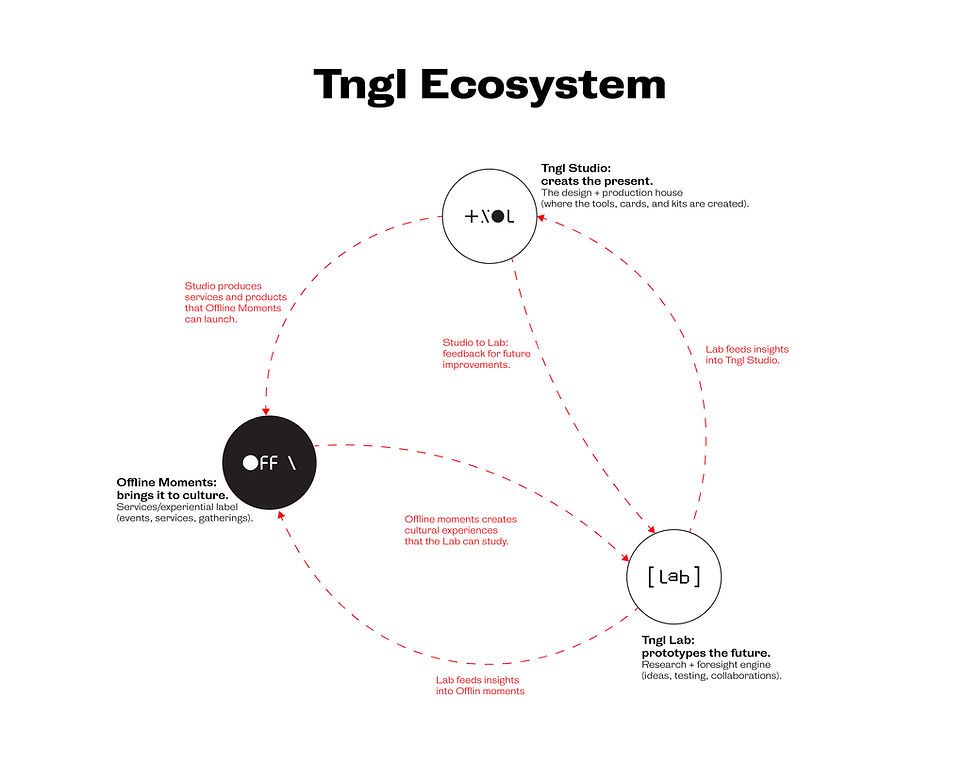The Tngl Ecosystem: Research → Design → Culture
- Tngl

- Sep 14
- 3 min read
At Tngl, everything we do—whether it’s designing a conversation tool, running a pop-up, or prototyping a social ritual—belongs to a bigger system of learning, testing, and evolving. That’s what the Tngl Ecosystem is. It’s not just a structure; it’s a way of thinking, working, and growing that reflects the complexity of human connection—and the importance of staying in tune with what’s ahead.
The ecosystem is made of three living units: Tngl Studio, Tngl Lab, and Offline Moments. Each of them has a distinct role. What makes the system strong is how these units continuously feed each other—looping between creation, experimentation, foresight, and cultural presence.

The Studio is where things are made. It’s the production house, the design floor, the core engine that turns ideas into tangible tools: card games, learning kits, visual identities, packaging, service concepts. But the Studio doesn’t operate in a vacuum. It builds the present based on what the Lab anticipates and what Offline Moments reveals. This means the Studio is not just making beautiful things—it’s creating what’s timely, useful, and grounded in real needs, informed by ongoing research and long-view thinking.
The Lab is where the future is prototyped—and where foresight plays its most active role. As the research and experimentation space, the Lab uses foresight to scan early signals, explore emerging shifts, and imagine alternative futures for human connection and belonging. This isn’t just abstract thinking. It’s how we stay one step ahead, testing ideas that may not yet exist in culture but are beginning to form in people’s desires, values, and behaviours. The Lab helps us prepare not just for what is, but for what might be coming.
What the Lab generates—new insights, speculative models, emerging needs—flows into the Studio as challenges to design around. The Studio gives these future-oriented ideas form and function: tools, cards, kits, methods. These then move into Offline Moments, where the real-world test begins.
Offline Moments is where it all meets people. It’s the cultural space where we see what happens when tools, rituals, and services are released into the wild. It’s not just events or experiences—it’s the embodiment of our work in everyday life. What Offline Moments does is reveal what resonates, what confuses, what transforms. These moments become data—not in the digital sense, but in the deeply human sense. Cultural data. Emotional data. Signals from the present that might also be seeds of the future. These are then fed back into the Lab for reflection, and into the Studio for iteration.
What this system offers is more than efficiency. It offers integrity. Every product or experience Tngl launches is backed by research, shaped through design, informed by foresight, and tested in real life. This circularity means we’re not chasing trends or guessing what people need—we’re building from insight, adjusting with care, and staying close to the world we’re trying to serve.
Why does this matter now? Because in a time of fragmentation, people and organizations need new forms of connection. Not just better tools—but better systems for learning, adapting, and evolving. The Tngl Ecosystem allows us to move quickly without being careless, and to scale ideas without losing their soul. By embedding foresight into how we think and work, we don’t just respond to change—we engage with it early, creatively, and responsibly.
For our team, it brings clarity. Everyone knows their role and how their work connects to the bigger picture. For our partners, it builds trust. They see that we don’t just launch things for attention—we launch things that come from somewhere and are going somewhere. And for the wider community, it offers something rare: a studio, a lab, and a cultural space that actually talk to each other, listen to each other, and learn from each other.
The Tngl Ecosystem is still evolving. But what grounds it is this belief: that meaningful connection—between people, ideas, and futures—is something we can design, if we build systems that are alive enough to listen, bold enough to imagine, and humble enough to adapt.



Comments